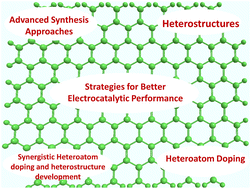Recent advances in nitrogen-doped graphene-based heterostructures and composites: mechanism and active sites for electrochemical ORR and HER
Abstract
The energy crisis, dependence on non-renewable energy resources and environmental pollution pose a great threat to the ecosystem. Consequently, the generation and utilization of hydrogen as a renewable, pollution-free, sustainable energy resource has attracted significant attention. In this case, different approaches have been explored, among which the electrochemical production of hydrogen through HER provides an efficient, green and clean approach for the mass production of H2. Besides HER, other reactions, such as OER and ORR, are core reactions involved in different electrochemical devices that are being developed to produce green energy technologies. In all these reactions, the development of low-cost materials with high electrochemical activity compared to the state-of-the-art noble metal electrocatalysts is important. Over the last few decades, different catalyst materials have been developed for HER, OER and ORR. Among them, graphene-based materials have been widely explored either as a support material or active catalyst for the above-mentioned electrochemical reactions. Specifically, the intrinsic electrochemical activity of graphene (G) is negligible, and therefore, different strategies, including heteroatom doping, composite development and development of heterojunctions, have been used to improve its electrochemical characteristics for HER/OER and ORR. However, although great advancements have been made using N-doped graphene (NG)-based heterostructures and composites as active electrocatalysts, there is still a lack of understanding of their reaction mechanism and the active sites responsible for the enhanced electrochemical performances are still under debate. Hence, considering the research interest over the past few years on NG-based electrocatalysts, herein we attempt to present a holistic summary of the recent advances made in the synthesis strategies and understanding of the role played by the interface, composite development and active sites in HER/OER and ORR over NG-based electrocatalysts.

- This article is part of the themed collections: Celebrating International Women’s day 2025: Women in green chemistry and 2024 Green Chemistry Reviews


 Please wait while we load your content...
Please wait while we load your content...